Emergency Operations Plan: A Comprehensive Guide for New York City
VerifiedAdded on 2021/06/18
|6
|1411
|134
Report
AI Summary
This report presents an Emergency Operations Plan (EOP) specifically designed for New York City, addressing the city's vulnerability to various natural disasters and emergency situations. The plan emphasizes the importance of proactive planning and preparedness to mitigate the impact of these events. It outlines a basic plan encompassing roles of governmental agencies, and considerations for special needs populations. The report highlights the need for functional and supporting annexes, as well as hazard-specific strategies. Key elements include lead agencies, coordination among diverse agencies, and resource allocation. The conclusion stresses the significance of EOPs in safeguarding lives and property, and the need for continuous improvement and adaptation. References from various sources support the plan's recommendations.
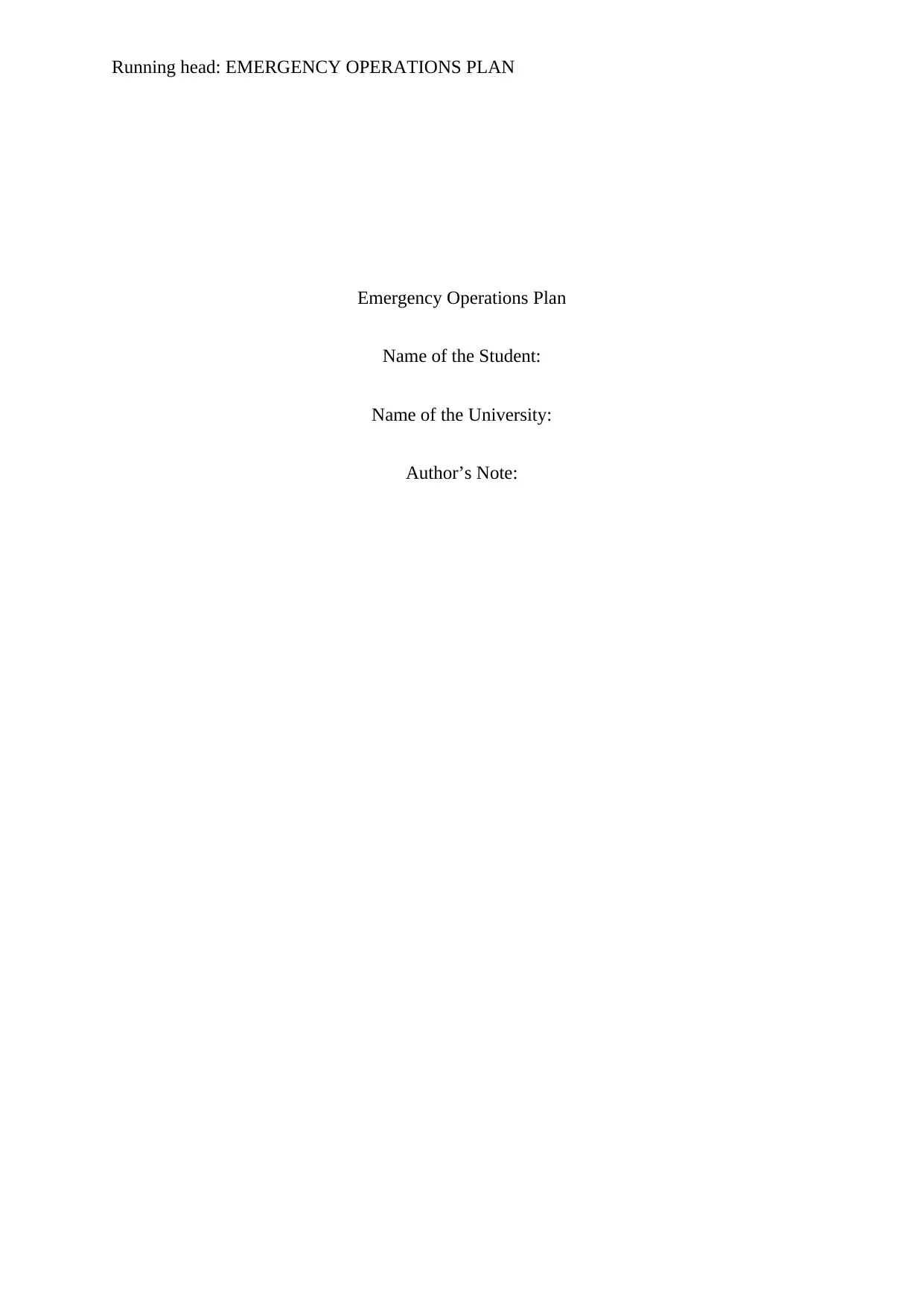
Running head: EMERGENCY OPERATIONS PLAN
Emergency Operations Plan
Name of the Student:
Name of the University:
Author’s Note:
Emergency Operations Plan
Name of the Student:
Name of the University:
Author’s Note:
Paraphrase This Document
Need a fresh take? Get an instant paraphrase of this document with our AI Paraphraser
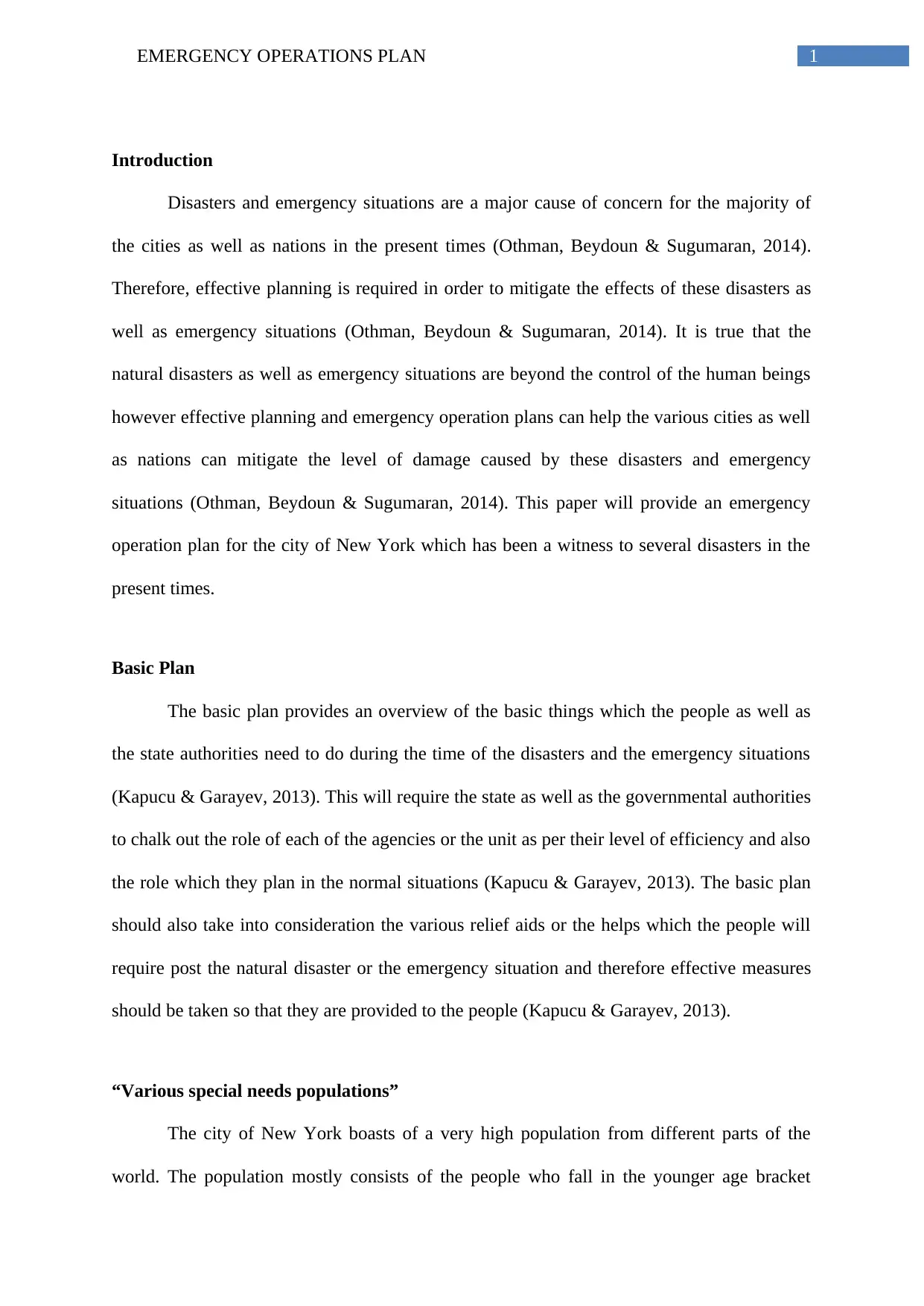
1EMERGENCY OPERATIONS PLAN
Introduction
Disasters and emergency situations are a major cause of concern for the majority of
the cities as well as nations in the present times (Othman, Beydoun & Sugumaran, 2014).
Therefore, effective planning is required in order to mitigate the effects of these disasters as
well as emergency situations (Othman, Beydoun & Sugumaran, 2014). It is true that the
natural disasters as well as emergency situations are beyond the control of the human beings
however effective planning and emergency operation plans can help the various cities as well
as nations can mitigate the level of damage caused by these disasters and emergency
situations (Othman, Beydoun & Sugumaran, 2014). This paper will provide an emergency
operation plan for the city of New York which has been a witness to several disasters in the
present times.
Basic Plan
The basic plan provides an overview of the basic things which the people as well as
the state authorities need to do during the time of the disasters and the emergency situations
(Kapucu & Garayev, 2013). This will require the state as well as the governmental authorities
to chalk out the role of each of the agencies or the unit as per their level of efficiency and also
the role which they plan in the normal situations (Kapucu & Garayev, 2013). The basic plan
should also take into consideration the various relief aids or the helps which the people will
require post the natural disaster or the emergency situation and therefore effective measures
should be taken so that they are provided to the people (Kapucu & Garayev, 2013).
“Various special needs populations”
The city of New York boasts of a very high population from different parts of the
world. The population mostly consists of the people who fall in the younger age bracket
Introduction
Disasters and emergency situations are a major cause of concern for the majority of
the cities as well as nations in the present times (Othman, Beydoun & Sugumaran, 2014).
Therefore, effective planning is required in order to mitigate the effects of these disasters as
well as emergency situations (Othman, Beydoun & Sugumaran, 2014). It is true that the
natural disasters as well as emergency situations are beyond the control of the human beings
however effective planning and emergency operation plans can help the various cities as well
as nations can mitigate the level of damage caused by these disasters and emergency
situations (Othman, Beydoun & Sugumaran, 2014). This paper will provide an emergency
operation plan for the city of New York which has been a witness to several disasters in the
present times.
Basic Plan
The basic plan provides an overview of the basic things which the people as well as
the state authorities need to do during the time of the disasters and the emergency situations
(Kapucu & Garayev, 2013). This will require the state as well as the governmental authorities
to chalk out the role of each of the agencies or the unit as per their level of efficiency and also
the role which they plan in the normal situations (Kapucu & Garayev, 2013). The basic plan
should also take into consideration the various relief aids or the helps which the people will
require post the natural disaster or the emergency situation and therefore effective measures
should be taken so that they are provided to the people (Kapucu & Garayev, 2013).
“Various special needs populations”
The city of New York boasts of a very high population from different parts of the
world. The population mostly consists of the people who fall in the younger age bracket
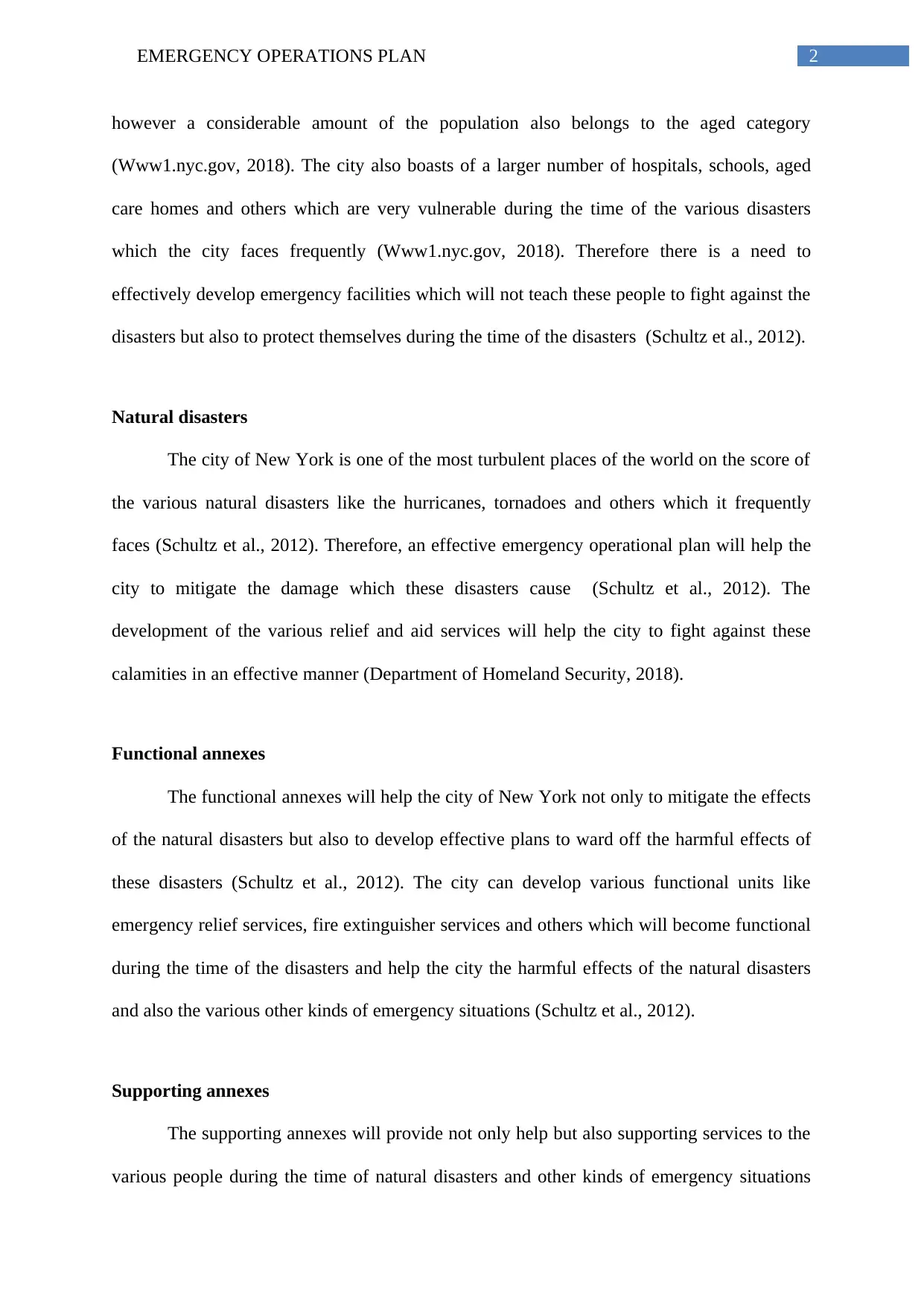
2EMERGENCY OPERATIONS PLAN
however a considerable amount of the population also belongs to the aged category
(Www1.nyc.gov, 2018). The city also boasts of a larger number of hospitals, schools, aged
care homes and others which are very vulnerable during the time of the various disasters
which the city faces frequently (Www1.nyc.gov, 2018). Therefore there is a need to
effectively develop emergency facilities which will not teach these people to fight against the
disasters but also to protect themselves during the time of the disasters (Schultz et al., 2012).
Natural disasters
The city of New York is one of the most turbulent places of the world on the score of
the various natural disasters like the hurricanes, tornadoes and others which it frequently
faces (Schultz et al., 2012). Therefore, an effective emergency operational plan will help the
city to mitigate the damage which these disasters cause (Schultz et al., 2012). The
development of the various relief and aid services will help the city to fight against these
calamities in an effective manner (Department of Homeland Security, 2018).
Functional annexes
The functional annexes will help the city of New York not only to mitigate the effects
of the natural disasters but also to develop effective plans to ward off the harmful effects of
these disasters (Schultz et al., 2012). The city can develop various functional units like
emergency relief services, fire extinguisher services and others which will become functional
during the time of the disasters and help the city the harmful effects of the natural disasters
and also the various other kinds of emergency situations (Schultz et al., 2012).
Supporting annexes
The supporting annexes will provide not only help but also supporting services to the
various people during the time of natural disasters and other kinds of emergency situations
however a considerable amount of the population also belongs to the aged category
(Www1.nyc.gov, 2018). The city also boasts of a larger number of hospitals, schools, aged
care homes and others which are very vulnerable during the time of the various disasters
which the city faces frequently (Www1.nyc.gov, 2018). Therefore there is a need to
effectively develop emergency facilities which will not teach these people to fight against the
disasters but also to protect themselves during the time of the disasters (Schultz et al., 2012).
Natural disasters
The city of New York is one of the most turbulent places of the world on the score of
the various natural disasters like the hurricanes, tornadoes and others which it frequently
faces (Schultz et al., 2012). Therefore, an effective emergency operational plan will help the
city to mitigate the damage which these disasters cause (Schultz et al., 2012). The
development of the various relief and aid services will help the city to fight against these
calamities in an effective manner (Department of Homeland Security, 2018).
Functional annexes
The functional annexes will help the city of New York not only to mitigate the effects
of the natural disasters but also to develop effective plans to ward off the harmful effects of
these disasters (Schultz et al., 2012). The city can develop various functional units like
emergency relief services, fire extinguisher services and others which will become functional
during the time of the disasters and help the city the harmful effects of the natural disasters
and also the various other kinds of emergency situations (Schultz et al., 2012).
Supporting annexes
The supporting annexes will provide not only help but also supporting services to the
various people during the time of natural disasters and other kinds of emergency situations
⊘ This is a preview!⊘
Do you want full access?
Subscribe today to unlock all pages.

Trusted by 1+ million students worldwide
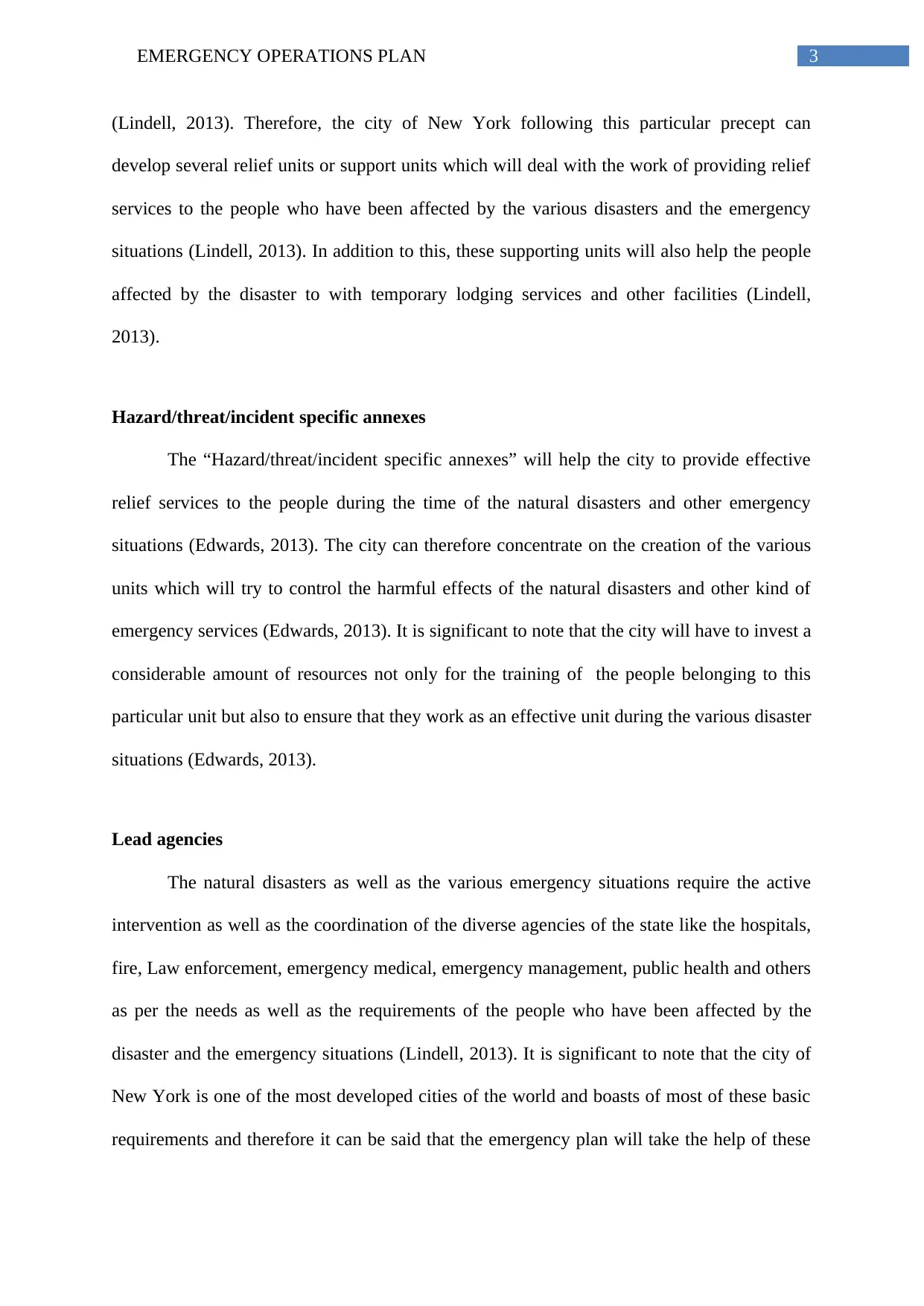
3EMERGENCY OPERATIONS PLAN
(Lindell, 2013). Therefore, the city of New York following this particular precept can
develop several relief units or support units which will deal with the work of providing relief
services to the people who have been affected by the various disasters and the emergency
situations (Lindell, 2013). In addition to this, these supporting units will also help the people
affected by the disaster to with temporary lodging services and other facilities (Lindell,
2013).
Hazard/threat/incident specific annexes
The “Hazard/threat/incident specific annexes” will help the city to provide effective
relief services to the people during the time of the natural disasters and other emergency
situations (Edwards, 2013). The city can therefore concentrate on the creation of the various
units which will try to control the harmful effects of the natural disasters and other kind of
emergency services (Edwards, 2013). It is significant to note that the city will have to invest a
considerable amount of resources not only for the training of the people belonging to this
particular unit but also to ensure that they work as an effective unit during the various disaster
situations (Edwards, 2013).
Lead agencies
The natural disasters as well as the various emergency situations require the active
intervention as well as the coordination of the diverse agencies of the state like the hospitals,
fire, Law enforcement, emergency medical, emergency management, public health and others
as per the needs as well as the requirements of the people who have been affected by the
disaster and the emergency situations (Lindell, 2013). It is significant to note that the city of
New York is one of the most developed cities of the world and boasts of most of these basic
requirements and therefore it can be said that the emergency plan will take the help of these
(Lindell, 2013). Therefore, the city of New York following this particular precept can
develop several relief units or support units which will deal with the work of providing relief
services to the people who have been affected by the various disasters and the emergency
situations (Lindell, 2013). In addition to this, these supporting units will also help the people
affected by the disaster to with temporary lodging services and other facilities (Lindell,
2013).
Hazard/threat/incident specific annexes
The “Hazard/threat/incident specific annexes” will help the city to provide effective
relief services to the people during the time of the natural disasters and other emergency
situations (Edwards, 2013). The city can therefore concentrate on the creation of the various
units which will try to control the harmful effects of the natural disasters and other kind of
emergency services (Edwards, 2013). It is significant to note that the city will have to invest a
considerable amount of resources not only for the training of the people belonging to this
particular unit but also to ensure that they work as an effective unit during the various disaster
situations (Edwards, 2013).
Lead agencies
The natural disasters as well as the various emergency situations require the active
intervention as well as the coordination of the diverse agencies of the state like the hospitals,
fire, Law enforcement, emergency medical, emergency management, public health and others
as per the needs as well as the requirements of the people who have been affected by the
disaster and the emergency situations (Lindell, 2013). It is significant to note that the city of
New York is one of the most developed cities of the world and boasts of most of these basic
requirements and therefore it can be said that the emergency plan will take the help of these
Paraphrase This Document
Need a fresh take? Get an instant paraphrase of this document with our AI Paraphraser
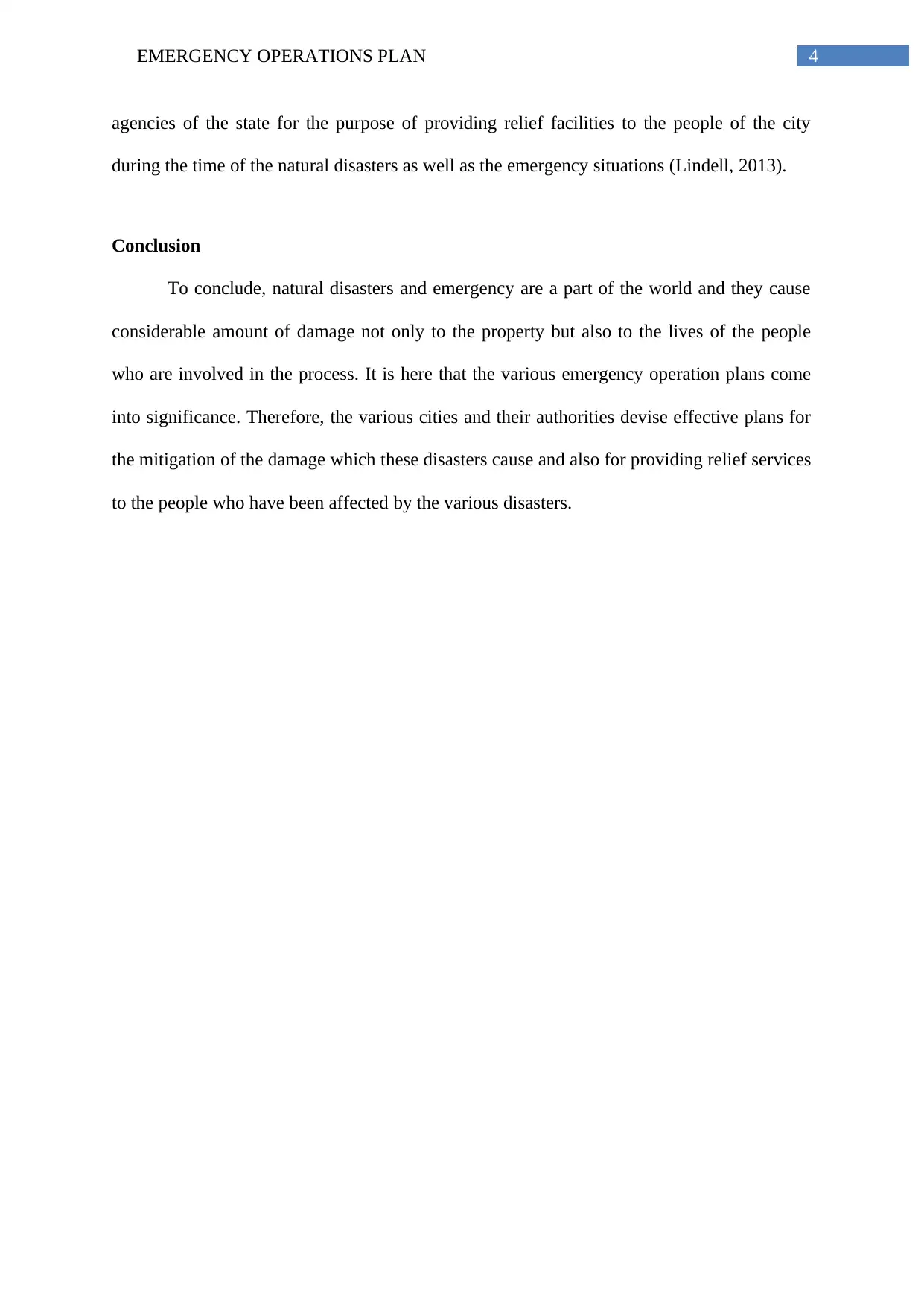
4EMERGENCY OPERATIONS PLAN
agencies of the state for the purpose of providing relief facilities to the people of the city
during the time of the natural disasters as well as the emergency situations (Lindell, 2013).
Conclusion
To conclude, natural disasters and emergency are a part of the world and they cause
considerable amount of damage not only to the property but also to the lives of the people
who are involved in the process. It is here that the various emergency operation plans come
into significance. Therefore, the various cities and their authorities devise effective plans for
the mitigation of the damage which these disasters cause and also for providing relief services
to the people who have been affected by the various disasters.
agencies of the state for the purpose of providing relief facilities to the people of the city
during the time of the natural disasters as well as the emergency situations (Lindell, 2013).
Conclusion
To conclude, natural disasters and emergency are a part of the world and they cause
considerable amount of damage not only to the property but also to the lives of the people
who are involved in the process. It is here that the various emergency operation plans come
into significance. Therefore, the various cities and their authorities devise effective plans for
the mitigation of the damage which these disasters cause and also for providing relief services
to the people who have been affected by the various disasters.
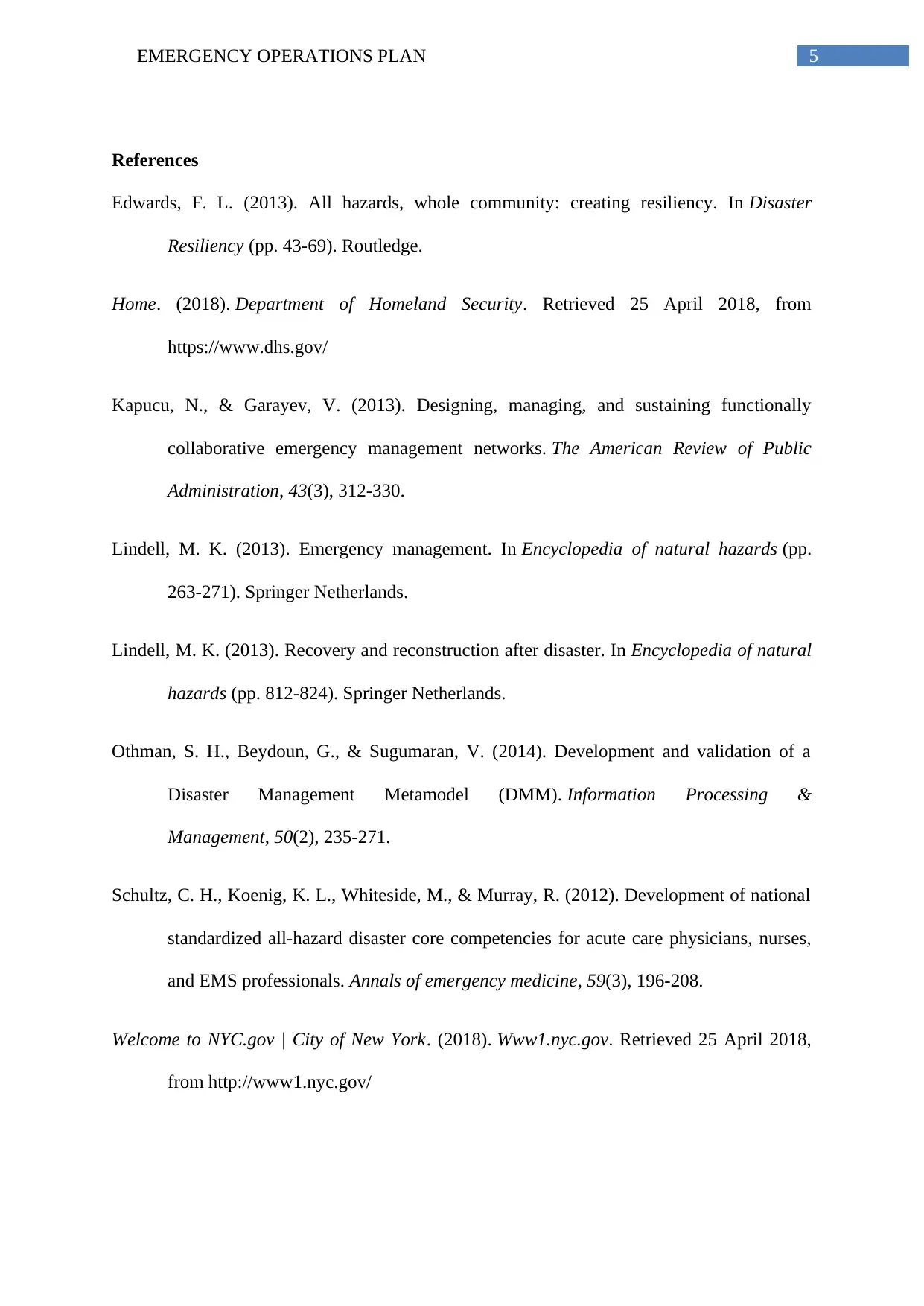
5EMERGENCY OPERATIONS PLAN
References
Edwards, F. L. (2013). All hazards, whole community: creating resiliency. In Disaster
Resiliency (pp. 43-69). Routledge.
Home. (2018). Department of Homeland Security. Retrieved 25 April 2018, from
https://www.dhs.gov/
Kapucu, N., & Garayev, V. (2013). Designing, managing, and sustaining functionally
collaborative emergency management networks. The American Review of Public
Administration, 43(3), 312-330.
Lindell, M. K. (2013). Emergency management. In Encyclopedia of natural hazards (pp.
263-271). Springer Netherlands.
Lindell, M. K. (2013). Recovery and reconstruction after disaster. In Encyclopedia of natural
hazards (pp. 812-824). Springer Netherlands.
Othman, S. H., Beydoun, G., & Sugumaran, V. (2014). Development and validation of a
Disaster Management Metamodel (DMM). Information Processing &
Management, 50(2), 235-271.
Schultz, C. H., Koenig, K. L., Whiteside, M., & Murray, R. (2012). Development of national
standardized all-hazard disaster core competencies for acute care physicians, nurses,
and EMS professionals. Annals of emergency medicine, 59(3), 196-208.
Welcome to NYC.gov | City of New York. (2018). Www1.nyc.gov. Retrieved 25 April 2018,
from http://www1.nyc.gov/
References
Edwards, F. L. (2013). All hazards, whole community: creating resiliency. In Disaster
Resiliency (pp. 43-69). Routledge.
Home. (2018). Department of Homeland Security. Retrieved 25 April 2018, from
https://www.dhs.gov/
Kapucu, N., & Garayev, V. (2013). Designing, managing, and sustaining functionally
collaborative emergency management networks. The American Review of Public
Administration, 43(3), 312-330.
Lindell, M. K. (2013). Emergency management. In Encyclopedia of natural hazards (pp.
263-271). Springer Netherlands.
Lindell, M. K. (2013). Recovery and reconstruction after disaster. In Encyclopedia of natural
hazards (pp. 812-824). Springer Netherlands.
Othman, S. H., Beydoun, G., & Sugumaran, V. (2014). Development and validation of a
Disaster Management Metamodel (DMM). Information Processing &
Management, 50(2), 235-271.
Schultz, C. H., Koenig, K. L., Whiteside, M., & Murray, R. (2012). Development of national
standardized all-hazard disaster core competencies for acute care physicians, nurses,
and EMS professionals. Annals of emergency medicine, 59(3), 196-208.
Welcome to NYC.gov | City of New York. (2018). Www1.nyc.gov. Retrieved 25 April 2018,
from http://www1.nyc.gov/
⊘ This is a preview!⊘
Do you want full access?
Subscribe today to unlock all pages.

Trusted by 1+ million students worldwide
1 out of 6
Your All-in-One AI-Powered Toolkit for Academic Success.
+13062052269
info@desklib.com
Available 24*7 on WhatsApp / Email
![[object Object]](/_next/static/media/star-bottom.7253800d.svg)
Unlock your academic potential
Copyright © 2020–2025 A2Z Services. All Rights Reserved. Developed and managed by ZUCOL.
